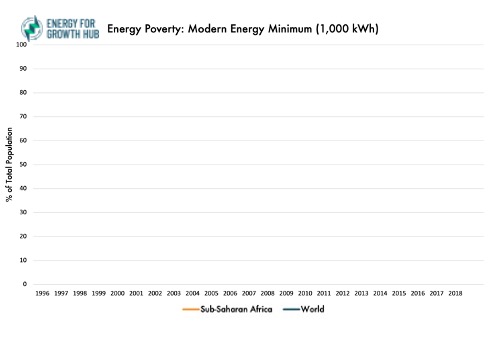Economists at the World Bank recently wrote that “poverty does not end when a household crosses the US$1.90 per person per day International Poverty Line.” We all know that higher levels of income are needed to improve livelihoods and expand economic opportunities. That’s why the Bank created higher income thresholds, including one at $5.50 per day to get a better sense of true progress against global poverty.
Using surveys, the Bank makes reasonable estimates at multiple thresholds to provide a broader picture of progression up the income ladder, especially in the ~100 countries where extreme $1.90/day poverty has been mostly eradicated. Here’s how we’re doing against the $1.90 and $5.50 income poverty lines, both globally and within sub-Saharan Africa:

The same concept applies to energy: Energy poverty does not end when a household gets connected to the grid or crosses the 100 kWh per person per year consumption threshold used by the International Energy Agency (IEA) to define electricity access. We all know that higher levels of consumption are needed to power appliances, job creation, and well-being. And that’s why we proposed a higher threshold, the Modern Energy Minimum at 1000 kWh per year, to get a better sense of true progress against global energy poverty.
Here’s how we’re doing:

The IEA provides reasonable estimates of basic electricity access but does not (yet) have a subsequent threshold to capture whether and how people are progressing up the energy ladder. Closing this gap is especially important in the ~150 countries where basic access is already close to 100%.
Figure 4 is intentionally blank; we don’t yet have the data needed to effectively track higher level energy gains. Calculating the Modern Energy Minimum requires two inputs: a national consumption average of at least 700 kWh per person outside the home and a headcount of individuals with per capita household consumption of at least 300 kWh. (The report explains why we chose two separate conditions — because energy is essential to both living standards and job creation.) The good news is that existing IEA data can be used to estimate the first non-household component. But we’re still lacking household consumption estimates beyond binary access, as well as any distributional data within countries.
In Annex 2 of the report, we show how to fix this relatively easily using an anonymized random sample of Kenya Power customers. The answer: in Kenya, 8% of citizens consume at least 300 kWh at home. But, of course, Kenya’s non-household average is still well below 700 kWh, so Kenya’s headcount for the Modern Energy Minimum is zero. Why is this important? Because while Kenya’s access rate (or the equivalent of the extreme energy poverty line) has risen from 15% in 2000 to 75% in 2018, the country still lacks sufficient power for vibrant economic growth. The Modern Energy Minimum provides countries like Kenya with two new, more ambitious targets to capture progress and focus efforts on both household and non-household consumption.
So what’s next?
- We compiled the existing data for 156 countries here. This shows that 90 countries hit the non-household component (and thus could potentially have a headcount above zero) along with 66 countries which do not.
- The IEA or World Bank could, as part of their regular course of data aggregation, collect data from utilities and other relevant national entities to estimate the distribution of household electricity consumption, as we have done in Kenya. That would allow an estimate of how many people consume at least 300 kWh per year.
- The next iteration of Sustainable Development Goal 7 — and, yes, there will be another round — could add the Modern Energy Minimum as a new performance indicator alongside universal basic access.

